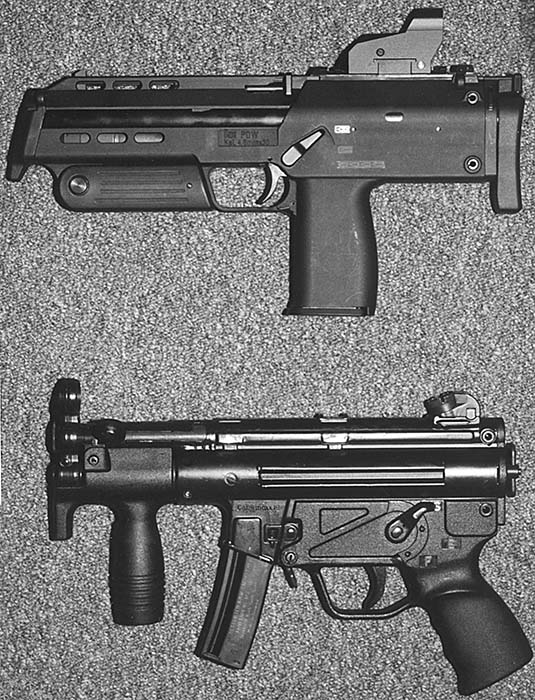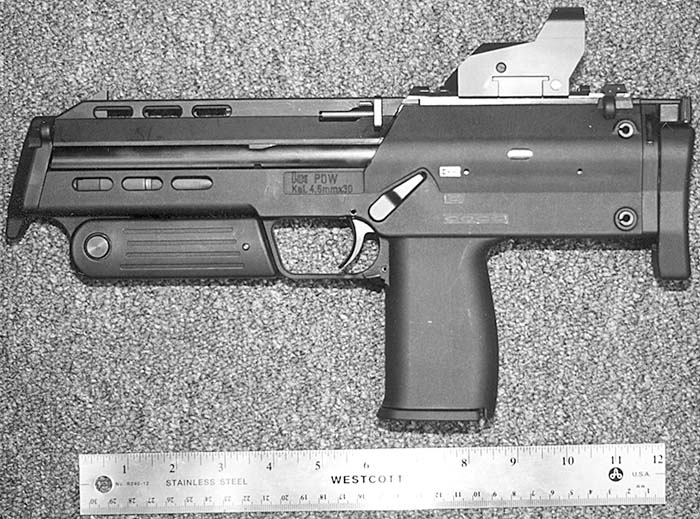By The Small Arms Review Editorial Staff
During a recent small arms symposium in the UK in September Heckler & Koch released information on a new Personal Defense Weapon for the first time publicly. Rumored for some time to be in development at HK’s “skunk works” in Oberndorf Germany, the existence of what some are calling a revolutionary weapon has been confirmed.
Little detailed information is available at this time and few photo’s. the new HK PDW is yet another totally new weapon from HK at a time when few other firearms companies are developing much of anything new. The PDW joins the ever increasing list of new HK’s along with the G36 and SL8-1 rifles, .45 and .40 caliber UMP submachine guns and various new pistol models like the USP Expert and a new centerfire .46 ACP carbine called the USC shown at the 1999 SHOT Show and expected to be available on the U.S. market later this year.
To describe the PDW as revolutionary as some may do may be stretching things a bit. As a bullet launcher this new PDW still kills by kinetic energy as firearms have been doing for centuries. Certainly this new personal weapon can be classified as a substantial development in this relatively new category of Personal Defense Weapons, small easily portable weapons about the size of a machine pistol or small submachine gun but a weapon shooting a non-pistol cartridge.
What is known about the HK PDW is that it is chambered for a new proprietary cartridge developed jointly by HK and Royal Ordnance, HK’s parent company and the UK’s premier small arms ammunition manufacturer. The PDW fires a small 4.6mm high velocity cartridge that looks more like a small rifle cartridge than that of a pistol round. The overall length of the round is 1.5 inches and contains a 25-grain projectile with a reported muzzle velocity of 2,378 feet per second. A copper-plated solid steel projectile develops @ 310 foot pounds of muzzle energy and is said to develop recoil far below that of 9mm handguns. According to the HK briefing presented in England the 4.6X30mm round will defeat threat body armor comprised of 1.6 millimeters of titanium and 20 layers of Kevlar at ranges beyond 200 meters with sufficient energy to inflict serious wounds after defeating the ballistic protection. Various types of rounds are under development to include a ball round, steel core penetrator round and a machined copper “CQB” cartridge for use in close quarters battle were over-penetration is unwanted. A tracer and frangible round for the PDW are also being finalized.
Actual firing prototypes of the PDW exist and have been appearing at the more recent U.S. defense expositions where the accompanying photographs were taken. Availability of production weapons is said to be scheduled for late 2,000 and ammunition is already in production and available from the Royal Ordnance factory in England. The weapon is very small indeed and resembles a large handgun. A briefing slide in fact compared the new HK PDW with the HK .45 ACP MK23 Pistol and while certainly larger the weight of the two weapons when fully loaded (20 rounds in the PDW, 12 rounds in the MK23) is nearly identical at 2.86 pounds. For sake of comparison the PDW is 1/2 inch longer than the HK 9mm MP5K without buttstock and just over two pounds lighter.

According to HK the PDW is designed to be fired effectively with one hand unlike the much larger and heavier FN P90 submachine gun, once referred to as a Personal Defense Weapon. The FN 5.7mm family of weapons that include the P90 and Five Seven pistol is clearly HK’s primary competitor in this relatively new weapons category. With its optional 40 round magazine fully loaded the HK PDW weighs in at 3.39 pounds compared with the P90 with 50 rounds loaded at over 7 pounds. The HK PDW is more than 6 inches shorter in length than the P90 as well making it far more portable as a true PDW must be.
According to HK’s data the 4.6mm round fired from the PDW provides the capabilities of a 5.56mm rifle or carbine out to ranges of just beyond 200 meters yet from a firearm that can actually be carried like a pistol. (SAR has not yet seen the gelatin tests or ballistics on this round) Shoulder rigs and thigh holsters offering quick deployment like that of a handgun holster are rumored to be under development by HK for their PDW. This looks like a head to head battle brewing between HK and FN in a weapons category that has yet to be embraced by many potential users but is slowly taking shape as future potential defensive armament for personal protection of military and law enforcement personnel.
What we know of the weapon is very interesting. A fold-down vertical foregrip is positioned forward of the trigger guard and below the barrel. This allows the weapon to be fired using one or two hands and in conjunction with a small slide-out buttstock concealed within the polymer receiver of the weapon. The fairly central location of the pistol grip, which houses the flush mounted 20-round magazine, allows for practical use as a one handed gun unlike most machine pistols.
The HK PDW is gas operated employing a clean shooting system rumored to be similar to that used so successfully in the HK G36 weapons system. A multi-lug rotating bolt head provides for a secure seal of the breech during firing. All operating controls of the PDW are fully ambidextrous to include the magazine and buttstock releases, the M16- like cocking handle and safety lever. The PDW provides the user with both semi-automatic and fully automatic modes of fire at a theoretical rate of @950 rounds per minute.
The HK Personal Defense Weapon provides the user with a forward assist, sling mounting positions and an integral Picatinny sight-mounting rail. The weapon is produced predominately from lightweight polymers and steel only when required. The PDW is said to require very little maintenance due to its unique short stroke gas operating system.

The sighting system for the PDW like the weapon itself is said to be still in the development stages. The sight pictured herein is being developed for Heckler & Koch by Hensoldt, a division of Zeiss, and like the dual sight on the HK G36 rifle uses a collector to capture ambient light and illuminate a small red aiming dot. This dot can be seen with both eyes open whether the weapon is fired at arms length like a pistol or when shot from the shoulder using the buttstock for additional support. A tritium source within the sight or a battery recharged by the solar collector is being considered to power the dot during periods of low or no light. This extremely small sight, like everything else about the HK PDW and 4.6mm ammunition, is designed for lightweight and portability. HK even designed their own simple rail grabber sight base for the PDW sight. The presence of the Picatinny mounting rail will allow a wide range of sights to be attached to the PDW using currently available rail grabbers. A fixed from sight pot is provided on the weapon as is an adjustable rear Patridge style sight.
Certainly this new Heckler & Koch Personal Defense Weapon marks a serious attempt to provide the true performance required of a personal weapon and in a package that can be easily carried and thus always available. If the weapon and new cartridge perform as claimed this new weapon could be the future choice of all categories of users. With a maximum effective range said to be somewhere between 200 and 300 meters the size of the weapon will allow it to be used effectively for VIP protection where the weapon must be concealed yet readily available It’s ability to defeat threat body armor and vehicle windshields and body panels would make it perfect for facilities defense where over-penetration and maximum range in urban areas might be of concern. Certainly in a classic role as a PDW for military pistols, drivers, artillery and armor crewman and behind the front line support personnel the PDW would be far better than a handgun and more portable and manageable than a rifle, carbine or smg, especially in confined spaces like vehicles, aircraft and within mobile communications trailers.
SAR will provide more detailed information on this newly emerging HK gun, as it becomes available.
| This article first appeared in Small Arms Review V3N6 (March 2000) |











